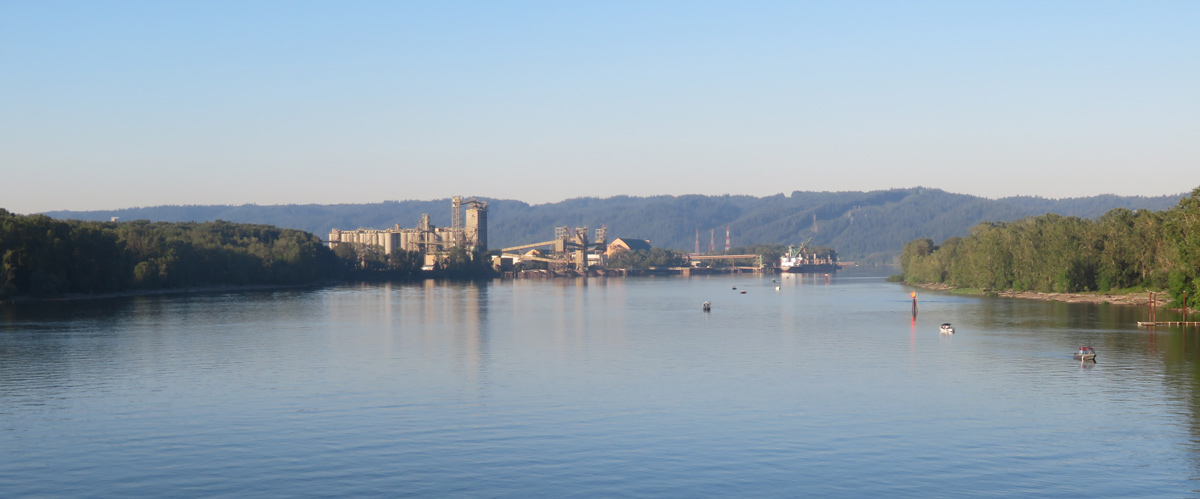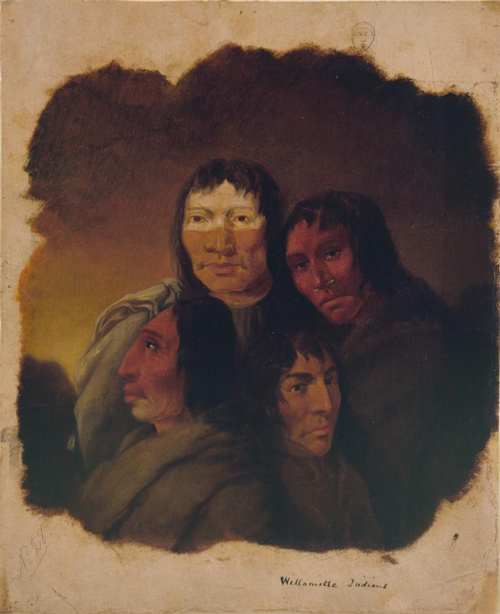Clark concludes his exploration of the Willamette River. On his way back, he learns that a smallpox epidemic had devastated the local population. The group at Provision Camp at present Washougal, Washington are greatly outnumbered by starving Native People, and Lewis demonstrates the air gun as a defensive measure.
Looking for a River
by Yellowstone Public Radio[1]Originally aired weekdays by Yellowstone Public Radio during the Bicentennial observance of 2003-2006. Narrated by Hal Hansen. Scripts by Whit Hansen and Ed Jacobson. Produced by Leni Holliman. © … Continue reading
Clark at the Willamette
Waters of California
the mist was So thick that I could See but a Short distance up this river. where I left it, it was binding to the East of S. E. being perfectly Satisfyed of the Size and magnitude of this great river which must Water that vast tract of Country betwen the Western range of mountains and those on the Sea coast and as far S. as the Waters of Callifornia
—William Clark
Multnomah Village
we arived at the residence of our Pilot which consists of one long house with Seven appartments or rooms in Square form about 30 feet . . . .
I indeavored to obtain from those people of the Situation of their [Multnomah] nation, if scattered or what had become of the nativs who must have peopled this great town. an old man who appeared of Some note among them and father to my guide brought foward a woman who was badly marked with the Small Pox and made Signs that they all died with the disorder which marked her face, and which She was verry near dieing with when a Girl. from the age of this woman this Distructive disorder I judge must have been about 28 or 30 years past, and about the time the Clatsops inform us that this disorder raged in their towns and distroyed their nation.
—William Clark
Clark’s Map of the Willamette
I provailed on an old man to draw me a Sketch of the Multnomar River ang give me the names of the nations resideing on it which he readily done
—William Clark
Four Clackama Indians (1847)
by Paul Kane (1810–1871)
Oil on paper, 10 5/8 x 9 7/16 inches (27 x 24 cm). Courtesy Stark Museum of Art, bequest of H.J. Lutcher Stark, 1965, collections.starkculturalvenues.org/objects/42790/four-clackama-indians?ctx=47dd4d55-7c0a-4060-a7e5-ed49bf5420fc&idx=236.
Clackamas Nation
their guide informed them that a large nation lived up the fork of this River by the name of Clack-a-mus [Clackamas] Nation of 30 Towns, and that another Nation lives along distance up this River where it gits Small by the name of Callah-no-wah Nation who are verry numerous.
—John Ordway
Lewis at Provision Camp
Starving Indians
The Indians continued to visit us today in considerable numbers most of them were decending the river with their families. these poor people appeared to be almost starved, they picked up the bones and little peices of refuse meat which had been thrown away by the party. they confirm the report of the scarcity of provision among the natives above.
—Meriwether Lewis
Air Gun Defense
at one time there was about 37 of those people in Camp Capt Lewis fired his Air gun which astonished them in Such a manner that they were orderly and kept at a proper distance dureing the time they Continued with him—
—William Clark
Weather Diary
State of weather at rise
Wind at rise
State of the weather at 4 P.M. Wind at 4 P.M. River cloudy after rain S W cloudy after rain W fallen 3 ½ in. a slight rain about day light this morng.
—Meriwether Lewis[2]To assist the reader of this web page, the date column is not presented, the “State of the Columbia River” columns have been merged, and some abbreviations have been spelled out.
Willamette River Confluence is a High Potential Historic Site along the Lewis and Clark National Historic Trail managed by the U.S. National Park Service. The confluence is best viewed from Kelly Point Park, managed by the City of Portland.
Sandy River Delta is a High Potential Historic Site along the Lewis and Clark National Historic Trail managed by the U.S. National Park Service. The 1400-acre Sandy River Delta park, managed by the U.S. Forest Service, has an extensive trail system.
Notes
| ↑1 | Originally aired weekdays by Yellowstone Public Radio during the Bicentennial observance of 2003-2006. Narrated by Hal Hansen. Scripts by Whit Hansen and Ed Jacobson. Produced by Leni Holliman. © 2003 by Yellowstone Public Radio. |
|---|---|
| ↑2 | To assist the reader of this web page, the date column is not presented, the “State of the Columbia River” columns have been merged, and some abbreviations have been spelled out. |




